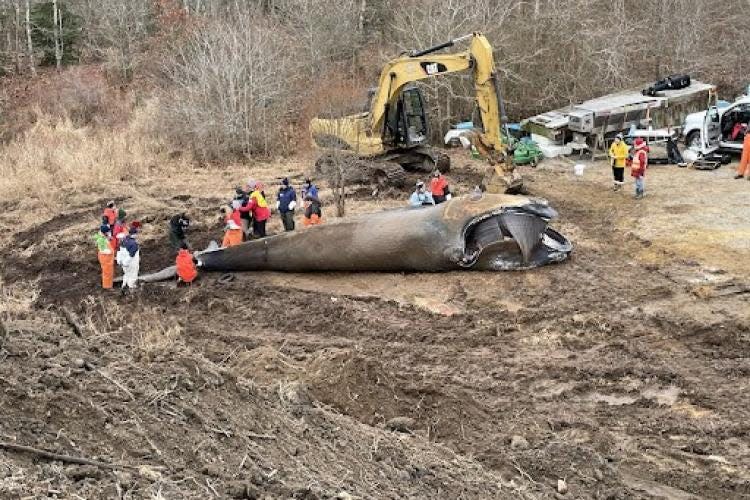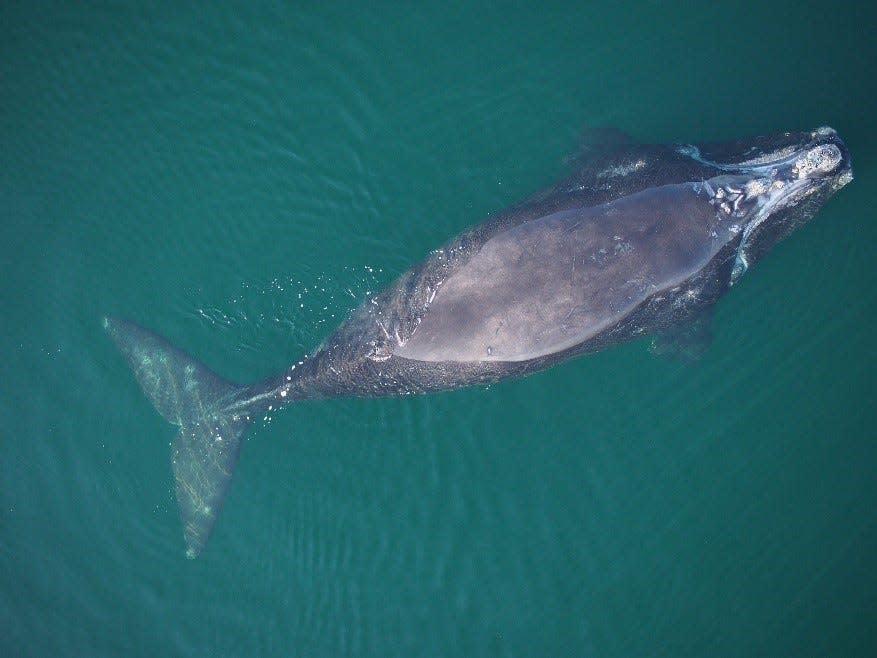Scientists look for clues to right whale death on Martha's Vineyard. It could take weeks.
For about half her life, the North Atlantic right whale that washed up dead Jan. 28 on a Martha's Vineyard beach lived with fishing rope wrapped around her tail and flukes, making her existence increasingly difficult and painful as she grew.
A team of more than 20 scientists last week conducted a necropsy on the 3-year-old female whale, looking for clues about her cause of death, which has yet to be determined, according to the National Oceanic and Atmospheric Administration's Fisheries Division. Researchers at the New England Aquarium's Anderson Cabot Center for Ocean Life were able to identify her as the 2021 calf of the right whale known as Squilla, the now approximately 17-year-old's only known calf.

The dead whale is listed in the North Atlantic right whale catalog as #5120 and was last seen alive in Cape Cod Bay in January 2023. Found washed up on Jan. 28 just south of Joseph Sylvia State Beach — a barrier beach along Nantucket Sound between Oak Bluffs and Edgartown — she was moved to Aquinnah for the investigation.
The Wampanoag Tribe of Gay Head (Aquinnah) offered a site on tribal lands on the southwestern side of the Vineyard to allow better access for heavy equipment and the large team of investigators, since the beach where the whale washed ashore was too narrow safely to do the probe.
The examination was led by a team from the International Fund for Animal Welfare headquartered in Yarmouth Port. Assisting were biologists from the Tribe, the Atlantic Marine Conservation Society, Whale Dolphin Conservation, the New England Aquarium, the Center for Coastal Studies, Marine Mammals of Maine, the Virginia Aquarium and the Canadian Wildlife Health Cooperative.
Tribal members conducted a private ceremony beforehand.
The procedure involves assessing the animal from the outside in for signs of trauma and illness, taking measurements and photos, collecting tissue samples from skin, blubber and internal organs to test for disease. The crew also examines the whale's eardrums for any acoustic trauma.
The necropsy "further documented the wounds and additional factors that may have contributed to the animal’s death," according to NOAA Fisheries.
The agency said preliminary findings may be ready soon, but other tests can take weeks to complete.
The agency will provide updates on its North Atlantic right whale updates page.
A worrisome entanglement: Whale lived with rope around her tail since 2022
Scientists have worried about the rope's effects on the whale's health for many months.
In May 2022, she had been seen in the Great South Channel, an undersea canyon between Nantucket and Georges Bank, without the rope. In August of that year, NOAA reported that Fisheries and Oceans Canada spotted the whale, whose tail was entangled, about 48 miles off New Brunswick.
"As the yearling grows, the entanglement is likely to cause increasing harm and eventual death as it constricts the tail and other areas of the whale’s body," the agency reported at the time.

In January 2023, a team from the Center for Coastal Studies in Provincetown made two attempts to help her — both were unsuccessful because of bad weather. Disentanglement efforts can be dangerous. In 2017, a volunteer disentanglement team member was killed while helping a whale in Canadian waters.
According to NOAA, when she was found on Jan. 28, rope remained wrapped around and embedded in the whale's tail. Some of the rope was turned over to NOAA's law enforcement office. The agency said that the rope "will now be examined by gear experts."
'Such pain and suffering.' What this whale's death means to a critically endangered species
Michael Moore, a senior biologist at Woods Hole Oceanographic Institution, and author of "We Are All Whalers: The Plight of Whales and Our Responsibility," helped with the initial management of the whale's remains on the beach on Monday and Tuesday.
"My past studies of such cases have left me in awe of how these animals can live for months and sometimes years with such pain and suffering," he said.
The whale's death needs to be understood in the context of its effect on the entire species, he said. Scientists estimate only about 356 of the critically endangered North Atlantic right whales are alive today, and relatively few of them are females who can give birth, according to the latest population study released last fall.
“The loss of this juvenile female is not only sad, but also represents the loss of tremendous potential for this species. We know of one female right whale in this population who has at least 30 descendants — calves, grandcalves, and great-grandcalves," said Philip Hamilton, a senior scientist at the New England Aquarium's Anderson Cabot Center in a statement the aquarium issued Friday.
The leading causes of death for right whales are entanglements in traditional fishing gear and injuries caused by vessel strikes.
"Our failure to adequately communicate the enormity of this animal welfare travesty continues to be deeply worrying," Moore said. "If such events were to be routinely occurring in and around our homes, we would do whatever it takes to adopt available sustainable seafood harvesting techniques, such as on-demand fishing systems, to avoid such entanglements."
Amy Knowlton, also a New England Aquarium senior scientist, said this whale's case "highlights the ongoing threat right whales and other whale species have been facing from fishing gear entanglements for decades."
In mid-January, NOAA reported a newborn calf that suffered severe injuries from an apparent boat strike off South Carolina. If the calf is unable to nurse, it will not survive. As of Jan. 11 it was reported to be alive, but scientists observed a large number of whale lice on the calf's wounds that can be a signal of declining health.
The whale that washed ashore on Martha's Vineyard was expected to be buried on tribal land.
Heather McCarron writes about climate change, environment, energy, science and the natural world. Reach her at hmccarron@capecodonline.com, or follow her on X @HMcCarron_CCT
Thanks to our subscribers, who help make this coverage possible. If you are not a subscriber, please consider supporting quality local journalism with a Cape Cod Times subscription. Here are our subscription plans.
This article originally appeared on Cape Cod Times: Whale found dead on Vineyard was entangled about half her life

